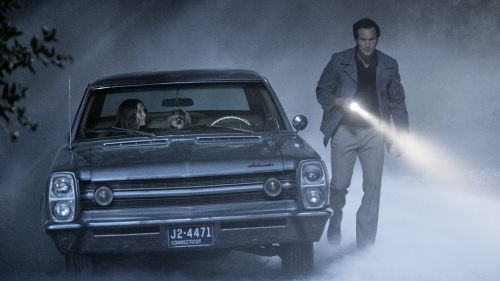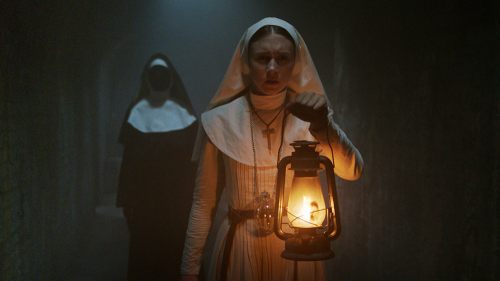ANNABELLE COMES HOME Review: Welcome To An Eerie Dollhouse
First, a necessary consumer advisory: The eponymous doll doesn’t have a terribly large role in Annabelle Comes Home. Now, the good news: you won’t necessarily mind. This third in the horror series spun off from the Conjuring films is, like its predecessor Annabelle: Creation, a significant improvement on the initial Annabelle, and also more satisfying than its franchise predecessor The Curse of La Llorona.
Annabelle Comes Home begins by flashing back all the way to the prologue of the first Conjuring (given how many spinoffs that movie has had, it’s hard to believe it’s only six years old), and demonologists Ed and Lorraine Warren (Patrick Wilson and Vera Farmiga) removing Annabelle from a home she’s been haunting. As the Warrens helpfully explain to her frightened owners, Annabelle isn’t possessed by a demon; only people can be possessed (which contradicts the previous films a bit, but never mind). The doll is instead a conduit for evil forces, and the Warrens take special precautions when they bring it home for safekeeping amidst their collection of occult mementos, placing it in a locked “chapel glass” cabinet within a downstairs room that is itself triple-locked.
Not that there’s much chance of their young daughter Judy (Mckenna Grace) going in there; she’s unnerved enough by her ability, apparently inherited from her mom, to occasionally see the spirits of the deceased. As a result, she has adopted religion, but her parentage (headlines questioning their practice have started showing up in local papers) is causing problems with her classmates. A young horror-film protagonist also having to deal with strife from other kids isn’t a new idea, but scripter and first-time director Gary Dauberman (who penned the other Annabelles as well as The Nun, and co-wrote It: Chapter One) brings sympathy and sensitivity to the portrayal of this troubled girl. Continuing in the Conjuring Universe tradition of showcasing strong child actresses, Judy is played with nuance and maturity by Grace, who was the preteen Tonya Harding in I, Tonya and young Theo in The Haunting of Hill House.
Similarly, while the overall narrative of Annabelle Comes Home doesn’t stray from a familiar path, Dauberman finds a number of fresh and creepy ways to fill in the details. When the Warrens head out on a new investigation, they leave Judy in the care of teenage babysitter Mary Ellen (Madison Iseman), a good girl whose kinda-bad-girl bestie Daniela (Katie Sarife) turns up to join them. It’s no surprise when, while Mary Ellen and Judy are distracted, Daniela hunts down the keys to that artifacts room and begins poking around where she shouldn’t, ultimately freeing Annabelle’s malevolence to draw bad mojo to the house. Yet Daniela has very personal motivations behind her curiosity about the spirit world, which are revealed gradually, leading to one of the film’s more potent shocks.
Adapting well to the Conjuring house style, Dauberman builds from small, subtle tingles, as other objects in that room come incrementally to life (among them a creepy monkey toy that looks like it’s auditioning to star in its own movie) to sudden jolts and several imaginative and clever creepouts. One that incorporates a 360-degree camera move is particularly shivery, as are a couple of bits involving antique coins tied to a ghoul known as the Ferryman. He’s one of a gallery of threats let loose against the girls that take the spotlight away from Annabelle, as if Dauberman realizes (perhaps correctly) that there’s not much more to be done with the doll herself by her third vehicle.
Once the first-act setup is established, Annabelle Comes Home’s plot essentially consists of Spooky Stuff Happening, then More Spooky Stuff Happening, then Really Spooky Stuff Happening. As such, since that action is confined entirely to the Warren home, it eventually becomes repetitive, and 10 or 15 minutes could have been beneficially trimmed from the 106-minute running time. As second sequels in the horror genre go, however, this one offers more than mere repetition of its predecessors, with Dauberman making the most of the opportunity to show his directorial stuff on a modestly scaled project. Which is not to say the film looks cheap; cinematographer Michael Burgess (son of veteran DP Don Burgess) suffuses it with atmosphere and touches of motivated giallo-esque colored lighting, and franchise regular Jennifer Spence contributes apt and evocative production design. (The filmmakers use just enough groovy decor, costumes and songs on the soundtrack to set the ’70s mood without belaboring the point.) Dauberman also throws in the right amount of leavening humor, from in-jokes—a glimpse on TV of a Raggedy Ann doll, which the real Annabelle was—to a setpiece that employs the inherent comedic value of chickens.
It’s also nice to see a film like this in which its terrorized young women are nonetheless able to find the strength and team spirit to take on the forces attacking them, without help from adults or guys (though Mary Ellen’s goofy would-be boyfriend Bob, played by Michael Cimino, has a moment or two). And for all the intense terrors the movie subjects the girls to, Dauberman has taken care not to make them too gruesomely explicit, or the movie otherwise unsuitable for young teen viewers. Not to damn it with the wrong praise, because it has quite a bit to offer grown-up viewers, but Annabelle Comes Home is likely to become a perennial at sleepovers



